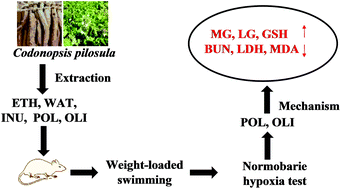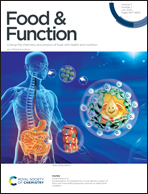Antifatigue and antihypoxia activities of oligosaccharides and polysaccharides from Codonopsis pilosula in mice†
Abstract
Codonopsis pilosula is a traditional Chinese medicine and food supplement that is widely used in China. This study aimed to investigate the antifatigue and antihypoxia activities of different extracts and fractions from C. pilosula, including ethanol extract (ETH), water extract (WAT), polysaccharides (POL), inulin (INU) and oligosaccharides (OLI). Different extracts and fractions were orally administered to mice at the doses of 0.25, 0.5 and 1.0 g kg−1 once a day for 21 days. Antifatigue activity was assessed through the weight-loaded swimming test on the 21st day, and antihypoxia activity was evaluated through the normobarie hypoxia test on the following day. Finally, biochemical parameters, such as liver glycogen (LG), muscle glycogen (MG), blood urea nitrogen (BUN), lactic dehydrogenase (LDH), malondialdehyde (MDA), and glutathione (GSH) levels, were determined. The results showed that, compared with the control treatment, only POL treatment significantly prolonged the swimming time of the mice. POL groups had the strongest hypoxia tolerance, followed by the OLI and WAT groups. The levels of LG and MG were significantly increased by treatment with POL at the doses of 0.5 and 1.0 g kg−1, whereas BUN and LDH levels in POL groups were significantly lower than those in the control group. MDA under POL and OLI treatment was significantly lower than that under the control treatment. In addition, treatments with POL and OLI, except for treatment with a low dose of OLI, significantly increased GSH levels. In conclusion, POL could efficiently enhance antifatigue and antihypoxia abilities by increasing energy resources, decreasing detrimental metabolite accumulation, and enhancing antioxidant activity. OLI could improve antihypoxia activity by preventing lipid peroxidation and enhancing antioxidant activity.



 Please wait while we load your content...
Please wait while we load your content...